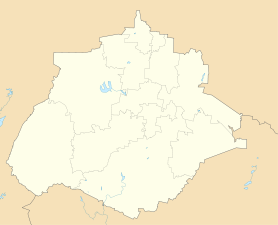Aguascalientes (city)
| Aguascalientes | |
|---|---|
|
Coordinates: 21 ° 53 ′ N , 102 ° 17 ′ W
Aguascalientes on the map of Aguascalientes
|
|
|
Location of Aguascalientes in Mexico
|
|
| Basic data | |
| Country | Mexico |
| State | Aguascalientes |
| Municipio | Aguascalientes |
| City foundation | 1575 |
| Residents | 722,250 (2010) |
| - in the metropolitan area | 932.298 |
| City insignia | |
| Detailed data | |
| height | 1885 m |
| Website | |
Aguascalientes ( Spanish : "warm water") is the capital of the central Mexican state of the same name , Aguascalientes .
The city has 722,250 inhabitants and is named after the thermal springs , which can be found in abundance there. It is known for the Feria San Marcos , one of the largest Mexican folk festivals , which takes place annually in April.
history
According to the official Spanish historiography of the time, the city was founded in 1575 under the name Nuestra Señora de la Asunción de Aguascalientes . The name is a reference to the warm springs that were found here and are now mainly used for swimming pools with healing properties. When the city was founded in 1575, the Spaniards wanted to get a fort to ward off rebellious Chichimecs .
economy
The Japanese car manufacturer Nissan has been operating Planta Automotriz Nissan in Aguascalientes since November 13, 1982 . The March , Versa , Note , Kicks and Sentra will be manufactured in 2019 .
In addition, Daimler and Nissan produce next-generation premium compact vehicles of the Mercedes-Benz and Infiniti brands in their joint venture production plant COMPAS (Cooperation Manufacturing Plant Aguascalientes).
Culture and sights
Museums
- The Museo de la Ciudad (Av. Zaragoza 505) has an exhibition on the city's colonial history and Spanish paintings.
- The Museo José Guadalupe Posada (Jardin Díaz de León Norte) has an extensive collection of works by the draftsman José Guadalupe Posada .
- In the colonial building of the Casa de la Cultura (Av. Carranza, Galeana) exhibitions, concerts and performances take place.
- The "Museo Nacional de la Muerte" (The Museum of Death) is located in three adjoining historic buildings in the city center. It shows the iconography of death, funerary art, and examples of death -themed folk art , particularly the Santa Muerte tradition , across Mexican history.
Buildings
- The Palacio Municipal, the baroque town hall, dates from the 17th century.
- The baroque cathedral of Aguascalientes was built in the 18th century.
Regular events
The Feria San Marcos , one of the largest Mexican folk festivals , takes place every year in April .
Personalities
sons and daughters of the town
- José Guadalupe Posada (1854–1913), artist
- Jesús Fructuoso Contreras (1866–1902), sculptor
- Ezequiel Adeodato Chávez Lavista (1868–1946), lawyer and university rector (UNM)
- José de Jesús López y González (1872–1950), bishop
- Saturnino Herrán (1887–1918), artist
- Alfonso Esparza Oteo (1894–1950), composer, pianist and singer
- Francisco Díaz de León (1897–1975), artist
- Gabriel Fernández Ledesma (1900–1983), artist
- Anita Brenner (1905–1974), anthropologist, art critic, historian, journalist, children's book author and translator
- Ernesto Alonso (1917–2007), actor, television director and producer
- Javier de la Torre (1923-2006), football player
- Jaime Humberto Hermosillo (1942-2020), film director
- William Paul Yarbrough (born 1989), football player
Other personalities
- Ramón Godinez Flores (1936-2007), bishop
- Luis Ernesto Pérez (* 1981), football player
Climate table
| Aguascalientes | ||||||||||||||||||||||||||||||||||||||||||||||||
|---|---|---|---|---|---|---|---|---|---|---|---|---|---|---|---|---|---|---|---|---|---|---|---|---|---|---|---|---|---|---|---|---|---|---|---|---|---|---|---|---|---|---|---|---|---|---|---|---|
| Climate diagram | ||||||||||||||||||||||||||||||||||||||||||||||||
| ||||||||||||||||||||||||||||||||||||||||||||||||
|
Average monthly temperatures and rainfall for Aguascalientes
Source: CONAGUA
|
|||||||||||||||||||||||||||||||||||||||||||||||||||||||||||||||||||||||||||||||||||||||||||||||||||||||||
Web links
Individual evidence
- ↑ NORTH AMERICA. In: nissan-global.com. Retrieved February 3, 2019 .



